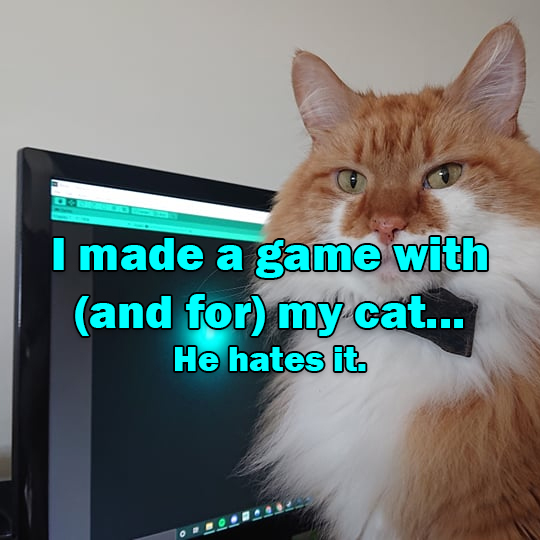
When thinking about how forces and play intersect, it’s hard to ignore that play in itself is a voluntary act. Can you “force” another to play? For this project I wanted to explore how non-human agency can be used to design interactive experiences, with and for animals. This required me to shift my thinking from a purely human perspective and consider design language that would translate to a cat.
To generate the initial bones of the project I worked with my cat to set up the guidelines for what I would need to create. This involved a series of play sessions with him, where I would get him to roll dice, or choose cards that had a direct influence on the design of the game. For example, a dice roll may influence if the game was about a moving dot, a bird or a fish. Although this ended up being random number generation, it formed a type of social play between us.
I then took these design concepts into Unity and created a digital experience intended to mentally engage him when I was unavailable. Because cats are by nature predators, I attempted to make the object he would engage with behave as much like a prey animal as possible. I also used colours that he would be able to perceive clearly, in high contrast and kept details minimal to not distract him.
Because this is an interspecies interaction our motivations and styles of play will differ. The length of time in a play session also varied depending on the time of day and if a previous session had occurred. I theorised that I could create a screen based toy that would keep him entertained and emulate physical play, a voluntary activity that is observed in many mammals and is recognizable by some revelatory behavioural patterns and indexical signs (Burghardt 2006). As noted by Westerlaken (2016) this would require specialised game design and research to create a meaningful player experiences for animals. Ultimately this requires a different focus compared to designing for humans.
I used play as a methodology for the work, by utalising random numbers, and limiting my own design input. By submitting to the rules I had laid out, it forced me to make decisions I otherwise wouldn’t have and freed me up to just go with the process
Although the process of creating the project was enjoyable and gave me a valid excuse to play with my cat instead of “working”, I can’t call it successful. What we ended up creating is something ultimately derivative of already existing cat games such as Mouse for Cats (2014) that he isn't actively engaging with. In the future, I would like to take more time and develop something that was specifically tailored to his interests. He will engage with screens passively, but rarely physically interact. This would mean creating something that requires him to move, chase and run. Using technology such as the Makey Makey system for example to create an experience that was capable of receiving physical input and dispensing rewards may receive more participation. I have not entirely abandoned the idea of creating digital play experiences for animals, but in the case of Anakin, he hates it.
Burghardt, G. M. (2006). The genesis of animal play. Testing the limits. London: MIT Press.
Westerlaken, M 2016, ‘Playful Animals: An Invitation to Participate’, in Proceedings of 1st International Joint Conference of DiGRA and FDG, viewed 25 August 2021, <http://www.digra.org/wp-content/uploads/digital-library/paper_211.pdf>.
Mouse for Cats. iOS, Android [Game]. Mouse for Cats.
About This Work
By Hayley Wilson
Email Hayley Wilson
Published On: 29/08/2021
